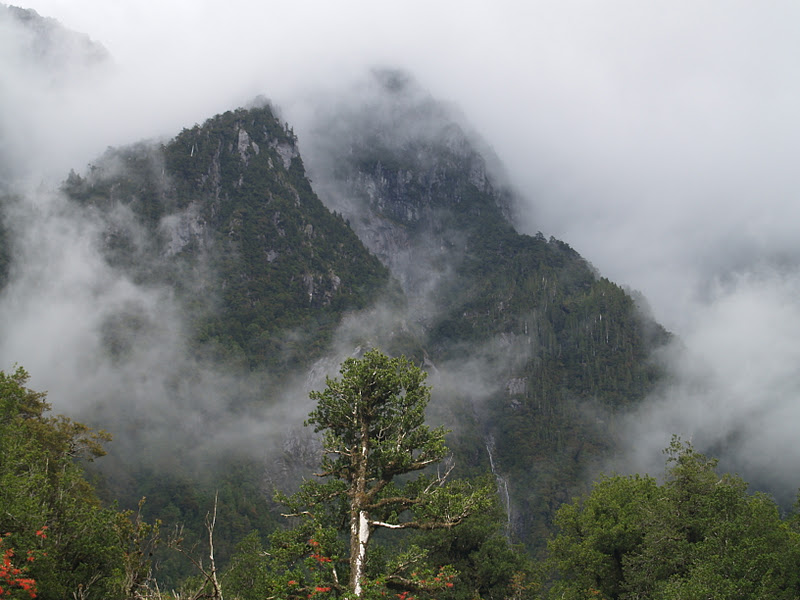We drive
then clamber through a forest of skeletons to reach ground zero: flattened
trees, decapitated trunks, all-consuming silver-grey ash and rock debris, with
a seething mountainous blister backdrop – the Chaitén volcano. Its steam and
pervasive eggy smell foretell a still angry volcano god, but scientists assert
he is gradually calming down after his 2008 eruption that affected life in this
part of the world so much. I’ve never seen anything like this before and
struggle, in awe, to imagine what it must have been like here meeting the
catastrophic force with the power to snap a four-foot tree trunk like a corn
stem.
 |
| On the Carretera Austral approaching the forest of skeletons in the distance |
 This
vista and the drive to get here reinforces in my mind that Patagonian Chile is
a geological contortion of immense proportions – a union of geo-forces that
contrive a unique landscape – tectonics, volcanoes, wind, rain, sea, ice and
snow, and biology. It’s raw, wild, isolated, and spectacular and the people who
live here remain at the mercy of these elements, despite their attempts to
civilize the land.
This
vista and the drive to get here reinforces in my mind that Patagonian Chile is
a geological contortion of immense proportions – a union of geo-forces that
contrive a unique landscape – tectonics, volcanoes, wind, rain, sea, ice and
snow, and biology. It’s raw, wild, isolated, and spectacular and the people who
live here remain at the mercy of these elements, despite their attempts to
civilize the land. |
| Return of the Nalca |
The
Chaitén eruption forced the closure of the popular southern part of Pumalin
Park for three years as roads were blocked for miles with fallen trees and
assorted mineral debris. They have only very recently been re-opened and Carlos
is hoping that this summer will see visitor numbers increase. After motoring
through forests shadowed by ice-capped mountains and passing reflective lakes,
we arrived at the beautifully-appointed El Volcáns camp-site on the flat valley
floor of the Rio Rayas, which has just been restored to its former glory after
the eruption. It was originally built on a site devastated by poor forestry
practices; now, the new buildings and camp-site shelters continue the Pumalin
design tradition that I am coming to expect. The camp-site will re-open in the
next few days
The regional town of Chaitén was almost erased from the map as the eruption smothered buildings and roads under several feet of volcanic ash, transforming the local geography. The authorities did a sterling job evacuating the population – apparently no-one died – but in the aftermath wrote the town off. Today, over three years since the earth burped, the local geography remains transformed: the beautiful bay is now a new delta of volcanic debris, the town’s river sports the skeleton of a fragmented timber building and many others remain half buried with grey ash. Rows of empty homes and businesses tell that many residents did not return; those that did seem to be slowly turning the volcanic tide. Tourist accommodation is increasing, reflecting the main economic driver based on the surrounding natural splendour. And all the time, the volcano, one of three in the immediate vicinity, steams ominously to the north at the head of its eponymous valley.
 |
| Another skeleton forest - view from the back |
We reach
the top of the hill, in the middle of a post-apocalyptic volcanic wasteland, to
suddenly happen upon a surprisingly fresh, green field. My first (speechless)
reaction is ‘golf course’ – incongruous as it appears, until Irwin explains
that this is a very recently restored camp site that was inundated under metre
of ash when Chaitén let rip. His team has just finished removing and leveling
the ash and planting new grass. They intend it to be open for the first time in
three years within a fortnight.
 |
| Gulley in place of the original path |
A couple
of hours later after a quick drive back, I am in Pumalin’s excellent Caleta
Gonzalo café. Carlo and his wife, as usual, serve me scrumptious, home-cooked,
local food. It’s getting dark outside and will be a much cooler night than of
late. The local ferry has just broken down causing a queue of waiting vehicles
up the slipway. Their occupants – people of all ages – are huddling around the
welcoming, crackling wood fire in the corner of the café so, for once, I am not
eating alone.






No comments:
Post a Comment